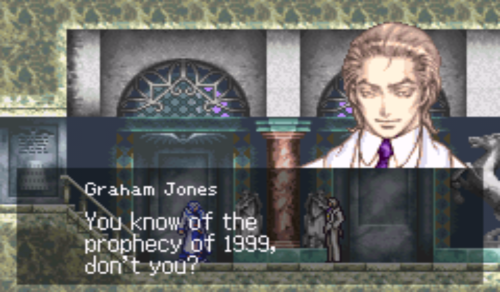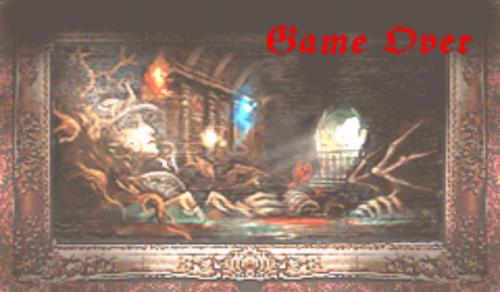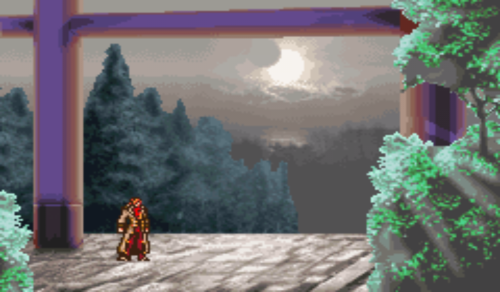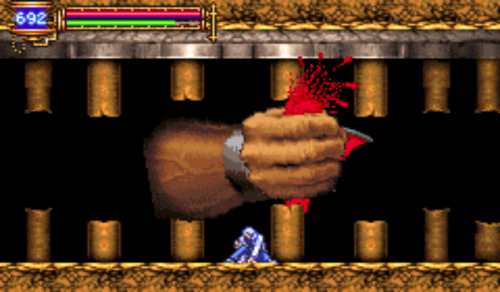Castlevania: Aria of Sorrow is the third and final Castlevania game on the GameBoy Advance. After playing through it for a while and even getting pretty close to gathering all the extras in a single game, my save slot is at 10 hours and 20 minutes, right before the final boss battle. That puts it between Circle of the Moon and Harmony of Dissonance on the length scale, probably slightly closer to Circle of the Moon, if you exclude the optional stuff. Why would you, though?
As with Harmony of Dissonance, I won’t even try to outright say which one is the best. I’ll just follow the format I established.
Game Report
The balance of difficulty seems to be the best in Aria of Sorrow, as I’m having trouble remembering any longer stretches of either frequent dying or low difficulty.
You start out with almost now extra movement abilities, so the early game ends up being quite linear, with very clear paths and goals. There’s some short branching here and there, but for the most part, it’s very difficult to get lost.
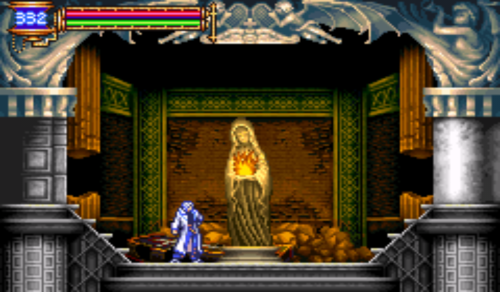
Pictured: Save Room. The animation is quicker than Circle of the Moon, but possibly slower than Harmony of Dissonance.
Since you’re pretty much limited to jumping and ducking in the movement department, the early bosses aren’t too complex either and mostly serve to familiarize you with the controls.
Save points are also more easily found thanks to the availability of three Castle Map items for the earlier areas of the castle. A Castle Map gives you a partial map of a part of the castle. The rooms are unlabeled, but you get the outlines, so all you have to do is check every smallest size room in the area and you’re bound to find a save point soon. Thanks to that, even if you do die, you don’t lose a lot of progression.
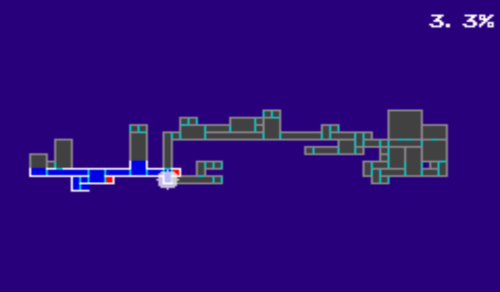
Pictured: Castle Map item in effect. You can see the outlines of some areas, but it’s also clear you have yet to visit them.
By mid game, the castle opens up and you get to explore it for lots and lots of secrets, but it remains difficult to get lost throughout the game. All I can remember are two points where I wasn’t sure through which of the three or four unexplored passages I have to double-jump/fly through.
The end game feels shorter than most, if you only count the required stuff. However, there’s much, much more to do in the optional department, so you do a lot of roaming through the almost fully explored castle to tie up loose ends.
As always, the basic ending is OK and doesn’t require you to do anything special. You simply go and beat the boss.
For the special ending, which I consider more canon, you have to collect three special souls and have them equipped while defeating the final boss. This is similar to the requirement of wearing the two bracelets in Harmony of Dissonance, but there’s no prerequisite of needing to have a set of relics in order to access the final boss – having the souls is enough.
Also as always, you unlock special modes for beading the game. There’s Boss Rush and a Sound Test, as well as a mode where you play as a bonus character, an extra level of difficulty for the regular game and finally, a New Game+, where you keep most of the stuff you collected, not including the things you need to actually progress through the game (exploration abilities and items.).
Castlevania: Aria of Sorrow – Features
Exploration abilities
The order I use to explain the mechanics in these games fails a bit in Aria of Sorrow because exploration abilities are a subset of the special system of mechanics this game uses – Souls.
Abilities
Exploration abilities come from ability souls, most of which you collect from special soul receptacles, usually found in rooms guarded by boss battles. A select few also drop randomly from monsters, so these are completely optional, but make exploration slightly easier or quicker, or simply more interesting.
| Grave Keeper | Backdash by pressing L |
| Skeleton Blaze | Slide by pressing Down + A |
| Malphas | Jump again in mid-jump |
| Kicker Skeleton | Kick during a double-jump by pressing Down + A |
| Hippogryph | Perform a high jump by pressing L in mid-jump. |
| Galamoth | Recognize places in which time has been stopped. |
In hindsight, some of the exploration abilities aren’t really exploration abilities.
Backdash actually is a requirement to enter a part of the castle, as there’s a gate that only opens if your back is facing it, so this was an interesting detail for me. The same goes for Slide, but that’s not exactly new.
Kicking isn’t an exploration ability at all – it’s simply a new move you earn as a drop from the Kicker Skeleton monster.
Galamoth provides the one ability that only serves to unlock a part of the castle, sort of like a key, so it’s nice knowing that the series has moved away from those types of abilities, for the most part.
Hippogryph’s high jump might sound like an exploration ability, but by the time you get it, nothing is really off limits to you anymore, so what the high jump actually does is to save you from changing what soul you have equipped and provide convenience more than anything.
Blue Souls
A few more exploration abilities come from blue souls, which you equip and then activate by holding (or pressing) the R button. While active, a blue soul expends MP.
| Flying Armor | Falling speed slows down and jump distance increases. |
| Giant Bat | Transforming into a bat gives you the ability to fly. |
| Black Panther | Generates shock waves while you dash. |
Flying Armor is something you get before double-jump, which actually feels like it improves the early pacing and slows down the speed at which castle areas open up. The effect it that it’s harder to get lost early in the game, which is great.
Giant Bat is a late-game soul gotten from one of the final few bosses and it basically serves to access the last few areas of the game and collect some optional items. It uses quite a lot of MP, so you can’t just fly around forever.
Black Panther is a convenience-only soul which you get from the final boss for the regular game ending. It makes Soma, the protagonist, dash forward and do a low amount of damage to anyone in front of him, so it’s great to quickly get through those lengthy early areas filled with enemies. It’s extremely convenient during soul and item collecting.
Yellow Souls
Some yellow souls also provide special exploration abilities. These are passive, so they don’t expend MP, but there’s a small level of annoyance in having to switch them around in these special areas.
| Undine | Walk on water surfaces. |
| Skula | Allows you to walk while underwater. |
Skula’s description is a bit misleading. Without this soul, Soma floats on water. With it, he sinks to the bottom, allowing him to walk around like there was no water at all, except the fall speed is slower.
A special mention is the Peeping Eye soul, which allows you to see breakable walls and makes finding hidden rooms a breeze, provided you actually take the time to get this soul.
A small hint here: One of the first Peeping Eye’s you encounter is right next to a breakable wall. This is the best place to get this soul, as you can quickly get in and out of that secret room, killing the eye and making it reappear as you reenter. It takes a while, because the drop chance is low, but this is by far the easiest place to get it.
A special combo
Lastly, there’s a special combination of souls which opens passage into a whole extra area of the castle.
There’s a waterfall which blocks passage. Equipping Undine with, for instance, a Devil soul allows Soma to break through. The Devil soul transforms Soma into a demon that rushes forward while the R button is held down. This is the soul I managed to do this with, but I do believe you can also do it with Curly or Manticore.
Leveling system
Leveling seems to be a slightly bigger deal than Harmony of Dissonance but not as big as in Circle of the Moon.
There are no Hearts in Aria of Sorrow, so what increases are HP, MP and the usual set of statistics. They don’t increase by a lot, but your health does more than double, possibly even triple by the end of the game. If you add the increase in Defense, end-game characters are much stronger than what you start with.
Equipment system
There are three equipment slots in Castlevania: Aria of Sorrow – a weapon slot, an armor slot and an accessory slot.
Weapons are where the game really shines, as there’s a lot of variety.
Most of it is swords, but even there, you get different types of swords. Some just do a regular, quick strike. Others do a wide, but slower quarter-circle swing. Others still do slower strikes, but with a bigger range.
Spears are sort of like the third category of swords, except the animation is slightly quicker, meaning you’re quicker to do the initial hit, but the swing also ends sooner, so you have to time it more precisely.
There are also special weapons, such as the whip sword, some knuckle dusters, and even a handgun. Some weapons also provide special effects, such as the ability to poison or petrify an enemy.
Overall, there’s a large amount of variety and many of the weapons are suited for different play styles.
Armors are not as varied and most of them simply increase your stats, but some do provide extra resistances or something similar.
Accessories also provide abilities or effects other than simple stat upgrades. They can increase drop rates of hearts (which refill MP), items, money or souls. They can even outright provide experience for walking around.
The thing about accessories, though… there isn’t that many of them. However, they are very nicely spread out throughout the game, so it always feels like you’re getting a cool new one.
Things like refilling of MP while standing still, walking or hitting are still in the game, but they are provided via souls, not equipment.
Special system
The special subsystems didn’t really play a major role in Harmony of Dissonance. This wasn’t the case in Circle of the Moon, but the card system there was relatively simple.
The soul system of Castlevania: Aria of Sorrow is probably the game’s biggest strength.
Soma has the ability to capture souls from monsters, enabling him to use their abilities. The souls are a random drop from every monster with some being much rarer than others.
There are three types of souls.
Red souls (bullet souls) are attack souls, expending MP on every use and used like a subweapon, by pressing Up and the Attack button at the same time. A few of these actually are the subweapons from the previous games, such as the Axe or the Knife. The rest of them are brand new. There’s about 55 of these in the game, according to my counting. Each is unique, though some are used similarly (forward projectile, arc, etc.).
Blue souls (guardian souls) are defensive souls. These are used with the R button, either by holding it, causing the ability provided by the soul to drain MP at a certain rate, or by pressing it to turn it on or off, again expending MP at a certain rate. There’s 24 of these and the abilities they provide vary greatly, ranging from different types of healing, to affecting how Soma moves around, summoning familiars, creating homing or partially homing projectiles, etc.
Yellow souls (enchanted souls) are passive souls. These don’t expend MP and simply provide an effect when equipped. Some of them provide simple stat bonuses, others provide new abilities or special moves, or they can add an effect to Soma’s attacks. It really varies a lot and it’s difficult to describe in a few words. There are 34 yellow souls.
Grey souls (ability souls) are simply the exploration abilities I’ve already listed. There’s six of them.
World, enemies, bosses
As before, some bosses have been demoted to enemies, while some enemies became bosses. Some early bosses also appear as regular enemies later, which is a first, I think.
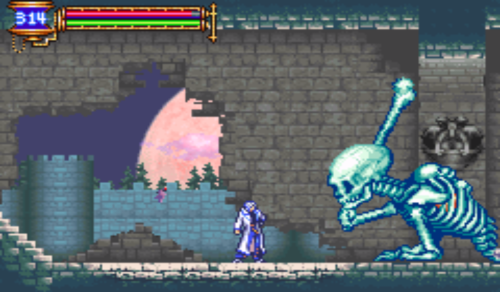
Pictured: Several Castlevania games follow the tradition of the first boss being something that’s barely holding together. This guy also appears later, as a regular enemy.
Unlike Harmony of Dissonance, there’s only one castle this time, but it’s a lot bigger compared to the one in Circle of the Moon. Bosses are fewer in numbers than in Harmony of Dissonance to.
You don’t feel like there’s less to do, though. It just feels less padded.
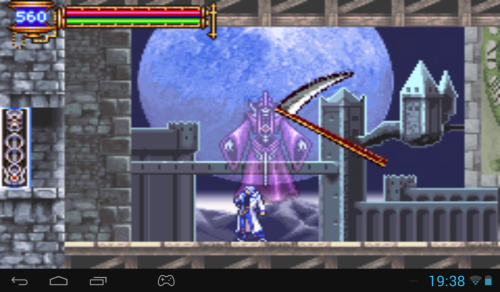
Pictured: Aria of Sorrow also has Death as a boss, though he/she/it isn’t exactly a major character.
The story adds a significant twist right from the start. Since I don’t have the initial report this time, here’s the text of the intro now:
The year is 2035.
Japan.
Crowds of spectators are gathering around in anticipation of the first full solar eclipse of the twenty-first century.
My name is Soma Cruz, and I am a high school exchange student studying abroad in Japan.
I live near the Hakuba Shrine, an ancient shrine with strong ties to Japanese mythology.
Mina Kahuba, the only daughter of the shrine’s caretaker, is both my classmate and my childhood friend.
I started making my way to the shrine to see the solar eclipse with Mina. But, for some strange reason, the stairway leading up to the shrine felt longer than usual, as if something was trying to keep us from our destination.
When I finally managed to get through the shrine gate, and my senses began to dim…
The pitch black sun is holding chaotic darkness together, trying to rouse a sleeping soul as if looking for its missing other half…
In short, you are Soma Cruz, and you’re somehow able to absorb monster’s souls. Through the game, you figure out why, but much sooner than that, you are told Dracula’s castle has been trapped within the eclipse, in order to contain Dracula’s powers, somehow. This has also already happened once, in 1999.
There are several other characters with you at least part of the way and they actually carry a big part of the story with them.
The story is still basic, but it’s noticeably less basic than the previous two games.
Economy
From Circle of the Moon, to Harmony of Dissonance, and now to Aria of Sorrow, writing about the economy of these three games is easy.
The upgrades are straightforward.
In Circle of the Moon, there was no economy.
In Harmony of Dissonance, there was money and there was a shop that sold some interesting items as well as basic necessities. You could buy these things, but you could only sell certain special precious jewels you can sometimes find in the game. You were not able to sell off old equipment. There were several possible shops within the castle, with different requirements needing to be fulfilled for each to appear.
The merchant is nameless and mysterious.
Money was a fixed drop from some candlesticks and other destructible castle features, so it was easy to collect.
In Aria of Sorrow, the merchant has a name and a back story. He sets up shop at the castle entrance and his item list gets updated as the game progresses. The items are less interesting overall, but there’s a specific item that’s your final goal – the Soul Eater Ring. It’s expensive, but worth it if you want to collect all the souls.
You are now able to buy something on offer, but also sell any item from your equipment or consumable inventory. It’s viable to collect certain valuable drops and sell them.

Pictured: Hammer is an ex-soldier who decides to open up a shop at the castle gates. Desertion is not an issue in the Castlevania world, I guess.
Money is now randomly dropped from anything, but there are select few spots where the drops are fixed.
Extra game modes and content
Soul collecting has a lot of randomness to it and chances are, you won’t have anything close to all the souls by the time you beat the game the first time, unless you go out of your way to collect them.
To address this, Aria of Sorrow offers New Game+. In this mode, you transfer all your soul and equipment and experience, excluding exploration abilities which would allow you to skip parts of the castle. This mode, as well as Hard difficulty for both this mode and a regular new game are unlocked once you beat the game once.
Another thing you unlock is the ability to play the game as Julius Belmont if you name a new save file JULIUS. Unlike the other two games, I actually checked this classic game mode out and even completed it in Aria of Sorrow.
There’s no start menu, so no levels or equipment of any kind. Julius starts out with all the exploration abilities available. His jump and double jump are also of greater range, probably to make up for lack of the Flying Armor soul. His high jump does some added damage to enemies and his backdash is actually some sort of strange forward dash where Julius phases out and is able to even go through the enemy, turning by 180 degrees during the move and enabling him to attack from the other side. It even works while Julius is in the air.
Julius also starts with all of the classic subweapons, allowing him to switch between them with the R button and he gets more powerful with every boss defeated. His MP doesn’t seem to regenerate on its own, but hearts do fill it up, so this is probably an approximation of the old heart system.
Fun fact; it took me about an hour and a half to beat the game as Julius. Once you know where to go and don’t have to bother with the other stuff, the game really is relatively short.
You’d think it would be different with no items, equipment or leveling, but you actually feel quite powerful as Julius Belmont. He is a vampire hunter, after all. His health doesn’t increase, however, so by the time you hit the final boss, it really does feel like a classic Castlevania, with you having a limited amount of hits and pattern memorization being a necessity.
There’s also boss rush. This time, you use an existing save to start boss rush, so you have all the equipment from that save available to you. Your time is tracked and your record is also stored to your save file. I have yet to get to the end of boss rush, though. I don’t think it’s especially difficult, but I didn’t invest the time to do it properly.
Lastly, there’s sound test and soul swap. The first should be clear and the second is something I can’t try out on an emulator.
As for extra in-game content, it’s all about soul and item collecting and you can track both through the monster encyclopedia. This is available from the start, not as an exploration ability and you can track which monsters drop what and see at a glance which souls you are missing.
Outside of these, there is no other added in-game content to my knowledge, unless you count the forbidden area, which you can only access with the special soul combination I already mentioned.
Memorable moments
Off the top of my head, I can think of two, both close to the end of the game.
The first is what starts like a boring battle against a Giant Bat boss. As in previous game, a swarm or flight of bats assembles into a giant one and you’re just about the start fighting it when a giant hand comes out of the cave in the background, grabs the bat and squishes it. Surprise! The boss is Balora, not a Giant Bat.
The other one is the lead up to the next boss fight (or the previous one, since you can do these two out of order). The area is called Underground Cemetery and you immediately see why. Corpses are climbing out of sepulchers and all walking towards the east, ignoring Soma who’s going in the same direction. This repeats for several screens until you find their destination – they are assembling Legion.

Pictured: One of the hallways leading up to Legion. The corpses lacking features sort of adds to the creepiness.
An honorable mention is the start of the game. You find your friend in danger, being attacked by winged skeletons. Some goes towards one of them hits it and absorbs its soul, immediately introducing the player to the game’s main mechanic.
Last words
Castlevania: Aria of Sorrow is, I think, the most polished and best made of the three GameBoy Advance Castlevania games. I’m not sure it’s the best one in the genre, but I’m sure it’s up there.
However, it’s also a game that seems to have the most grinding of the three. It doesn’t approach the point of being excessive, but it’s, in my opinion, it can be a dangerous road to walk on. Collecting souls now is great, but in the direct sequel on the DS, Dawn of Sorrow, it gets a bit tedious, as far as I can remember and from what I hear.
Still, Aria of Sorrow gives Symphony of the Night, which is considered the best one by a lot of people, a run for its money.

